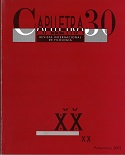Els derivats d'«esse» i «stare» en les llengües romàniques
DOI:
https://doi.org/10.7203/caplletra.30.4961Keywords:
verb llatí «esse», verb llatí «stare», llengües romàniques, anàlisi contrastiva, Abstract
Abstract
This paper presenta a contrastive analysis of the Romance verbs derived from ESSE and STARE. The lexical and syntactic
characteristics of these verbs in Latin and their locative and atributive uses clearly contrast with actual Romance uses. This contrast
highlights the variable extension of the verbs derived from STARE assuming the space of those derived from ESSE.One extreme of the
clyne is represented by the Hispanic languages (i.e., Spanish, Portuguese and Catalan), which have developed more uses and thus
extended further the STARE forms. On the opposite extreme, there is French, which has no STARE uses. In between, there are Occitan,
Sardinian, Italian and Romanian, which include some forms derived from STARE, but their extension is inferior to the extension reached in the Hispanic languages. The analysis focusses on the factors that have interacted and influenced on this extension of use and points to the present tendencies.
 Downloads
Downloads
Downloads
Published
How to Cite
-
Abstract458
-
PDF (Català)290
Issue
Section
License
Authors submitting work to Caplletra for publication must be the legitimate holder of the usage rights. Legitimacy for the purposes of publishing the work must also include images, tables, diagrams and any other materials that may complement the text, whether they are the author of such material or not.
Copyright: on publishing their work in the journal, the author grants Caplletra. Revista Internacional de Filologia usage rights (reproduction, distribution and public communication) for both the paper printed version and for the electronic version.
All work published in Caplletra is covered by the Creative Commons license type Attribution-NonCommercial-NoDerivatives 4.0 (CC BY-NC-ND 4.0).
RESPONSABILITY
Caplletra. Revista Internacional de Filologia does not necessarily identify with the points of view expressed in the papers it publishes.
Caplletra. Revista Internacional de Filologia accepts no responsibility whatsoever for any eventual infringement of intellectual property rights on the part of authors.






